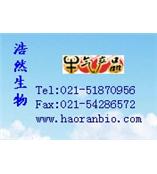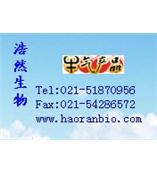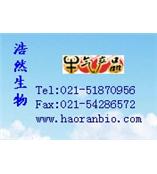Rapamycin(Sirolimus,雷帕霉素,西罗莫司)现货热销
来宝网 2011/3/28点击2721次
Rapamycin 雷帕霉素
上海浩然生物订购电话:021-51870956
在线QQ:470003480
中文名:雷帕霉素;西罗莫司
英文名: Sirolimus;Rapamycin
说明: 雷帕霉素(Rapmnycin)是从吸水链霉菌Streptomyces hygroscopicus中分离出来的三烯大环内酯类抗生素,它是一种新型高效免疫抑制剂,同时又是一种有效的抗真菌剂并具有抗肿瘤的作用。
抑制原理:可能通过阻断IL-2启动的T细胞增殖而选择性抑制T细胞,用于抗移植排斥反应。
LC Laboratories相关资料如下:
R-5000 Rapamycin, >99%
|
M.W. 914.17
|
C51H79NO13
|
[53123-88-9]
RTECS: VE6250000 |
M.I. 12: 8288
|
M.I. 14: 8114
|
Storage: Store at or below -20 ºC.
Solubility: Soluble in DMSO or ethanol (up to about 50 mg/mL for either solvent).
Disposal: A
View the MSDS for this product:
· Immunosuppressant, related to FK-506, but without calcineurin inhibitory activity even when complexed to FK-506 binding protein. Selectively blocks signaling that leads to p70 S6 kinase activation (IC50 = 50 pM). Terada, N., et al. "Failure of rapamycin to block proliferation once resting cells have entered the cell cycle despite inactivation of p70 S6 kinase." J. Biol. Chem. 268: 12062-12068 (1993). Fingar, D.C., et al. "Dissociation of pp70 ribosomal protein S6 kinase from insulin-stimulated glucose transport in 3T3-L1 adipocytes." J. Biol. Chem. 268: 3005-3008 (1993). Price, D.J., et al. "Rapamycin-induced inhibition of the 70-kilodalton S6 protein kinase." Science 257: 973-977 (1992). Chung, J., et al. "Rapamycin-FKBP specifically blocks growth-dependent activation of and signaling by the 70 kd S6 protein kinases." Cell 69: 1227-1236 (1992).
· Lymphokine-induced cell proliferation at the G1 phase is inhibited and apoptosis in a murine B cell line is induced by rapamycin. Rapamycin arrests the Saccharomyces cerevisiae cell cycle irreversibly in the G1 phase. Morice, W.G. ,et al. "Rapamycin-induced inhibition of p34cdc2 kinase activation is associated with G1/S-phase growth arrest in T lymphocytes." J. Biol. Chem. 268: 3734-3738 (1993). Kay, J.E., et al. "Inhibition of T and B lymphocyte proliferation by rapamycin." Immunology 72: 544-549 (1991). Heitman, J., et al. "Targets for cell cycle arrest by the immunosuppressant rapamycin in yeast." Science 253: 905-909 (1991).
· Due to a different mechanism of action than cyclosporin and FK506, rapamycin may prove to be important in organ transplant patient therapy. Fewer side effects than the standard anti-rejection treatments have been observed. Proliferation of activated T cells, but not apoptosis, is blocked by rapamycin. The induction of apoptosis of rejection-causing T cells reduces the tendency towards transplant rejection. Schwarz, C. and Oberbauer, R. "The future role of target of rapamycin inhibitors in renal transplantation." Curr Opin Urol. 12: 109-113 (2002). Wells, A.D. et al. "Requirement for T-cell apoptosis in the induction of peripheral transplantation tolerance." Nat. Med. 5: 1303-1307 (1999). Li, Y., et al. "Blocking both signal 1 and signal 2 of T-cell activation prevents apoptosis of alloreactive T cells and induction of peripheral allograft tolerance." Nat. Med. 5: 1298-1302 (1999).
· We note that one of our competitors, Selleck Chemical, advertises 99.9% purity for its rapamycin. This claim is not credible in general chemical terms for this complex natural product, nor in terms of available analytical techniques. Furthermore, we have had Selleck’s rapamycin analyzed by a highly experienced and expert clinical analytical laboratory that specializes in rapamycin analyses. Using liquid chromatography - mass spectrometry, they found a purity of 96.7% (cis plus trans) for a lot of Selleck’s rapamycin. In contrast, we have proven our rapamycin to be greater than 99% in purity for every lot, no exceptions.
· More on the subject of rapamycin purity: HPLC analysis of rapamycin is somewhat complicated. Rapamycin forms several chromatographically separable species in solution, consisting perhaps of different conformers, tautomers, hydrates and/or isomers, but they are all in equilibrium with the major form, trans-rapamycin. We have shown this by collecting the individual impurity peaks in our rapamycin product and individually re-injecting them into the HPLC. In each case, upon re-injection the collected impurity peak is reduced or absent, and the major peak is again trans-rapamycin, of ~95% purity or higher, thus confirming re-equilibration back to the major trans-isomer of rapamycin.
Because we find that all significant impurities (generally, those above 0.1%) in our product, including the cis-isomer, are in equilibrium with the trans isomer in the solution used for analysis, the actual purity of our product is >99% rapamycin, in all of its equilibrium forms. In contrast, material from other suppliers typically contains impurities that do not equilibrate with trans-rapamycin, and thus are genuine contaminants.
These results also indicate that it is probably not possible to obtain the trans isomer in pure form, because in solution it will quickly re-equilibrate to the mixture of cis and trans.
· Rapamycin formulations for in vivo use: Many of our customers have asked for information about preparing formulations of rapamycin for administration to animals. Here are several journal citations and links for information on this topic:
’)
http://circ.ahajournals.org/cgi/content/full/99/16/2164’)
describes a vehicle for rapamycin injection consisting of a rapamycin suspension in 0.2% carboxymethyl cellulose and 0.25% polysorbate-80. They don’t say how the suspension was done; one way is to thoroughly agitate or grind the rapamycin in the vehicle. Another way, probably better and easier, is to dissolve the rapamycin at high concentration in DMSO, dimethylformamide or dimethylacetamide, then dilute into the aqueous vehicle--this should give a very fine suspension if agitation is good during addition of the DMSO solution. Injection was i.m. Gallo, R., et al. "Inhibition of Intimal Thickening After Balloon Angioplasty in Porcine Coronary Arteries by Targeting Regulators of the Cell Cycle." Circulation 99: 2164-2170 (1999).
’)
http://www.pnas.org/cgi/reprint/96/15/8657.pdf’)
describes a similar protocol; these workers dissolved the rapamycin in dimethylacetamide, then added it in 1:24 proportion to a vehicle of (final conc.’s) 10% polyethylene glycol (MW avg. = 400) and 17% polyoxyethylene sorbitan monooleate. Injection was i.p. in mice, total vol. of 100 µl. Rivera, V.M., et al. "Long-term regulated expression of growth hormone in mice after intramuscular gene transfer." Proc. Natl. Acad. Sci. USA 96: 8657-8662 (1999).
’)
http://ajpendo.physiology.org/cgi/content/full/279/5/E1080’)
used 0.75 mg/kg rapamycin in 5% dimethyl sulfoxide, for injection into pigs via jugular vein catheter. Kimball, S.R., et al. "Feeding stimulates protein synthesis in muscle and liver of neonatal pigs through an mTOR-dependent process." Am. J. Physiol. Endocr. Metab. 279: E1080-E1087 (2000).
’)
http://www.bloodjournal.org/cgi/content/full/100/3/1084’)
injected rapamycin in 51% wt/vol polyethylene glycol 300 (PEG300), 2.5% wt/vol polysorbate 80, 10% vol/vol ethanol, i.p. Hackstein, H., et al. "Rapamycin inhibits macropinocytosis and mannose receptor-mediated endocytosis by bone marrow-derived dendritic cells." Blood 100: 1084-1087 (2002).
’)
http://cancerres.aacrjournals.org/cgi/content/full/62/24/7291’)
injected rapamycin i.p. in mice by diluting an ethanol stock solution of rapamycin first into sterile 10% PEG400/8% ethanol and then that solution was further diluted into an equal volume of sterile 10% Tween 80 for a final concentration of 20 µg rapamycin/100 µl. (Most of this information is in the Materials and Methods section of the paper, but the "ethanol stock solution" is mentioned under the Cell Culture and Antibodies section, and the additional details are found in the Regrowth Delay Assay section.) Eshleman, J.S., et al. "Inhibition of the Mammalian Target of Rapamycin Sensitizes U87 Xenografts to Fractionated Radiation Therapy" Cancer Res. 62: 7291-7297 (2002).
· The solubility of rapamycin in 50/50 DMSO/water, as used in osmotic pumps, is about 0.5 mg/mL at ambient temperature.
· Quantitation of rapamycin, metabolites and related compounds such as everolimus and FK-506 in blood, tissues and other matrices is offered as a service by Rocky Mountain Labs (’)
Rocky Mountain Labs’)
). This firm is not affiliated with LC Labs.
· Sold for laboratory or manufacturing purposes only; not for human, veterinary, food, or household use.
· Please see also our other standard immunosuppressant products:
|
品名
|
产地
|
货号
|
规格
|
单价
|
备注
|
产品说明书
|
|
雷帕霉素Rapamycin
|
LC
|
R5000
|
50MG
|
询价
|
现货
|
|
|
雷帕霉素Rapamycin
|
LC
|
R5000
|
100MG
|
询价
|
现货
|
推荐仪器


